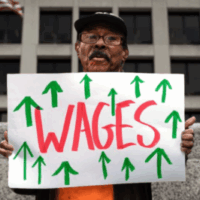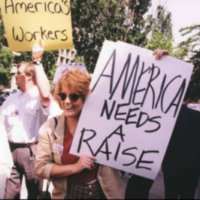Real wages for most U.S. workers remain below 2009 levels, but minimum wage increases prove highly effective as stop-gap measure for workers in the lowest-paid jobs.
A full decade after the official end to the Great Recession, corporate profits and labor productivity are on the rise, but many workers still receive paychecks that don’t outpace the rate of inflation. The one bright spot is among workers who have actively called for, and won, minimum wage increases from lawmakers and some large corporate employers. Starting with the majority Black and Brown fast-food workforce in New York City in 2012, workers in low-paid industries across the country have organized to demand a higher wage floor. The result: Raises for millions of U.S. workers and some significant reversals of wage declines for the lowest paid. Nevertheless, despite the low unemployment numbers that typically predict wage increases, most U.S. workers’ real wages remain below 2009 levels.
Since the official end of the Great Recession in 2009, NELP has tracked occupational wage changes for groups of workers along the wage distribution. In our previous analyses of 2013 and 2014 data, before the recent upsurge in state and local minimum wages, we found that workers in the lowest-paid occupations had disproportionate declines in real wages during the recovery. Between 2009 and 2014, the bottom quintile saw real wages decline by 5.7 percent compared to 4 percent for U.S. workers overall.[1]
In this brief, we update our previous analysis with the most recent data available and find that these trends have reversed dramatically in the intervening years, particularly in the states that raised minimum wages. Our analysis shows:
- Occupations in the bottom fifth, which lost the most ground earlier in the recovery, saw median real wage increases of 3.6 percent between 2009 to 2018 (Figure 1).
- In those states that implemented minimum wage increases between 2013 and 2018, the bottom fifth gained close to four percent (Figure 2). By contrast, in the states without minimum wage increases between 2013 and 2018, the bottom fifth did not experience real wage growth, with real wages remaining stagnant (0.5 percent decline) since the end of the recession (Figure 2).
- All other groups experienced stagnancy—with very small overall increases or decreases in purchasing power during this period (less than 2 percent). (See Figure 1.)
The wages gains made by the bottom fifth in recent years are indeed a bright spot in the post-recession labor market, but it is important to note that these gains did not benefit all racial groups equally. The modest success of minimum wage raises did little to redress deep-rooted racial wage inequality in this country. A recent study revealed that Black workers have received far smaller pay increases during the recovery compared with other racial groups, despite falling unemployment rates.[2] This reality is a bleak reminder that while minimum wage policies are effective at setting a wage floor, they are a blunt tool at best. Future organizing and policymaking efforts to address the problem of wage stagnation must include targeted strategies to address systemic racism in the labor market in order to meaningfully improve outcomes for Black workers.
Download the data brief to read more.
Endnotes
[1]. Irene Tung and Claire McKenna, Occupational Wage Declines Since the Great Recession, NELP, 2015.
https://www.nelp.org/publication/occupational-wage-declines-since-the-great-recession/
[2]. Eric Morath and Soo Oh, As Wages Rise, Black Workers See the Smallest Gains, Wall Street Journal, April 16, 2019. https://www.wsj.com/articles/as-wages-rise-black-workers-see-the-smallest-gains-11555437942



